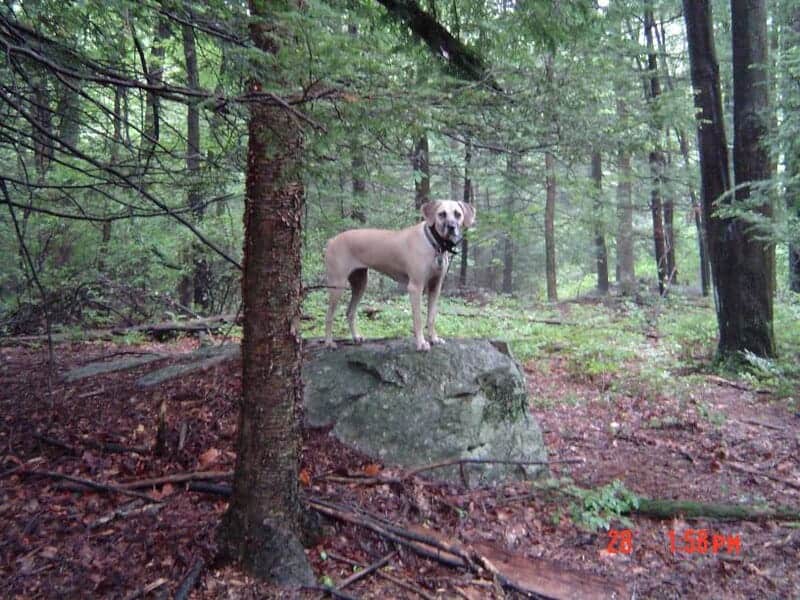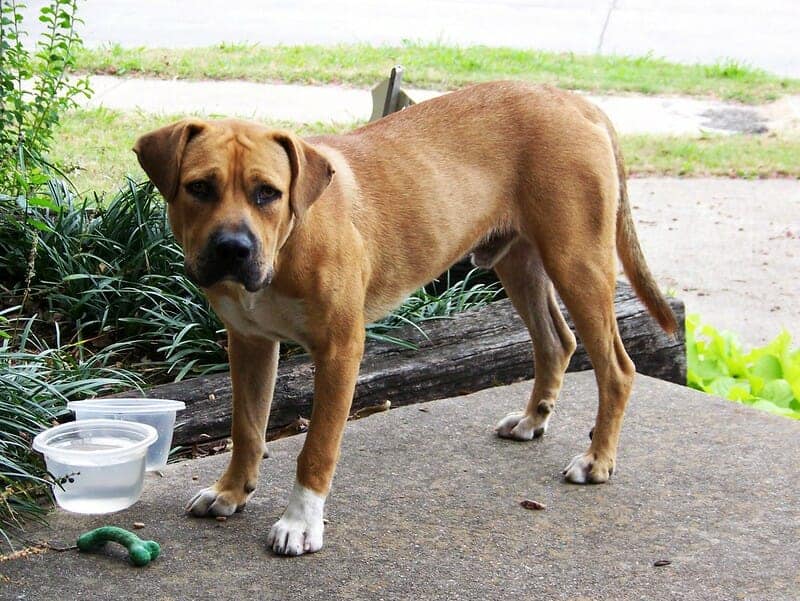The black mouth cur is an all-around utility dog that has been helping families survive in the southern United States for centuries. These fearless and loyal working dogs will take on any task given to them and have the energy and devotion to see it through. But that same drive can make these dogs difficult to keep as a typical family pet.
Keep reading to find out if the black mouth cur is the right “wingpup” for you.
Contents
General Characteristics of the Black Mouth Cur
- Other names: Southern Cur, Yellow Black Mouth Cur
- Height: Over 16 inches
- Weight: 30 to 100 pounds
- Lifespan: 12 to 16 years
- Origin: Southern USA
- Colors: Fawn, red, yellow, cream, and brindle all with or without a black mask
- Activity level: High
- Grooming needs: Low
- Best suited for: Experienced active owners who have a job for their dog to do
While a BMC with a dark mask around its mouth and muzzle is most common, these dogs can also be seen without it. They will still have the namesake black lips even if they lack the darker hair around them. “Jackson” by Funky Chickens / CC BY-NC-ND 2.0
The History of the Black Mouth Cur
Despite being a uniquely American breed, there are currently no curs accepted by the AKC. This lack of breed standard and written pedigree is one reason the history of the black mouth cur is so difficult to decipher, especially when trying to differentiate it from other types of cur in the region.
Cur hounds were originally developed by pioneers of the American deep south to help with a long list of jobs necessary for survival. They were observant watchdogs ready and willing to keep trespassing humans and animals at bay as well as great hunting dogs.
Similar to coonhounds and other mixed-use hunting dogs of the region, these dogs could track game across large areas through dense forest. They were capable of treeing raccoons, digging up burrows, and even taking down hogs.
The black mouth cur, especially, seemed well adept at livestock herding and was often used to round up cattle and pigs on small ranches.
The variable nature of the BMCs job led to a wide variation in appearance as well as distinct, traceable lineages.
BMCs can be as small as 30 pounds, perfect for covering long distances and tracking small game. Or as large as 100 pounds and built to protect property and hunt wild boar. Their color is also quite inconstant, with any solid color containing minimal white markings accepted, though tan coloring is the most common. Regardless of whether a dog has a black mask, all BMCs have black lips and dark gums.
Like all curs, the black mouth is especially adept at working in the thick forests of the southern United States. They can follow game trails for miles and corner game in burrows or up trees. This particular BMC has been trained to track black bears for research purposes. “Lucy Poses” by Don / BY CC-NC-ND 2.0
Southern black mouth curs, Ladner black mouth curs, foundation black mouth curs, and Howard line curs are all distinctive types within the breed. Some are better suited for herding while others for hunting, but all are capable of performing a variety of tasks.
Today, many BMCs still perform their traditional role as a strong and capable working dog. But more recently, these dogs have become more popular as companion animals and even as competitors in dog sports and as participants in search and rescue missions.
The Temperament of the Black Mouth Cur
At the heart of any cur is a working dog waiting for a job to do. These are highly driven, highly active hounds. Without a proper outlet for their energy, they can become destructive, obsessive, and depressed.
These dogs make great companions for hunters as well as small ranch owners who need an all-around utility dog to perform various tasks. They are highly intelligent and can pick up new commands and behaviors with ease assuming their handler is patient and kind and provides the right motivation.
Black mouths are typically lanky with elongated heads similar to foxhounds and plott hounds. However, types that are bred to bring down large game like boar tend to be more squarely built with larger heads similar to a Catahoula leopard dog. Personality can also vary from puppy to puppy the same way. “Img_7823” by Christine Burger / CC BY-ND 2.0
For the companion cur, a consistent outlet for instinctual drives and plenty of exercise are a must. They do best in homes with very large yards and free-range to roam between the house and yard.
Even with daily walks and a lot of room, these dogs need something to keep their attention. Doggy daycare, training classes, scent work, agility, and herding trials are all great ways to provide the mental and physical stimulation these dogs need.
If these needs are met, these hounds can be very warm and affectionate family dogs. They are loyal to their people but often aloof with strangers. While they make great guard dogs for property, they tend to be less territorial when away from home and can be quite social in the right setting.
Overall, the BMC is a highly active dog who will do best in a stimulating environment with plenty of outlets for all that energy. They make great hiking partners and are a good choice for individual owners as well as families.
You can learn more about what it takes to own a BMC in the video above.
Health Issues Common to the Black Mouth Cur Breed
The wondering and ranging genetic history of the BMC has only served to benefit them in terms of health. These dogs are not widely plagued by genetic problems and are one of the longer-lived breeds of their size.
Still, there are some health issues that have been found in the breed, including:
- Mange
- Skin issues
- Ear infections
- Eye problems
- Epilepsy
Most BMC health issues are preventable with proper care and a quality diet.
They owe much of their robust health to their long history as working dogs. For centuries, these dogs functioned as tools to be used around the homestead or ranch. Any dogs that were not useful due to behavior problems, lack of drive, or health issues were not bred.
This keen focus on ability rather than physical looks is one way that being overlooked by organizations like the AKC has really helped this breed thrive. Because there are no hard rules on how the dog should look, only on how it should perform, this breed has evolved to fit the description of whichever task they are being used for in that region. And all without the health problems often caused by inbreeding.
The black mouth has a relatively long lifespan for a dog their size. Though they tend to be healthy, it is important to be prepared to care for an aging dog as they get into their golden years.
While these traits work in the dog’s favor, they can make purchasing a cur puppy somewhat of a gamble. Without a strict pedigree, you can never be entirely sure what your new pup will grow into. They may be on the larger side and well-muscled, or more streamlined and petite.
In general, these dogs have a well-established personality, but it is much more likely to find outliers in breeds like this than in breeds such as the golden or lab, who have been bred from relatively limited gene pools multiple times in their history as a way to preserve a specific look.
If you would rather not roll the dice on which of the many BMC variants you could end up with, you could always adopt a cur. There are many BMC and hound rescues, especially in the south that are looking to place adoptable adult dogs in their forever homes.
Do Black Mouth Curs Do Well With Children and Other Pets?
While BMCs are known for being territorial and aggressive when necessary, such as during hunts and when herding, they are also known to be quite gentle with children they know.
These dogs often get possessive of children in the family and will bond with them as deeply as they have with their main handler. As a dog with an endless amount of energy, having an active older child around can be very beneficial for the dog, too.
But, as with any canine, it is always important to supervise dog-child interactions, especially with younger children and toddlers.
With plenty of early socialization and enough training, black mouths make great companions for children. Their inert loyalty and love of play make them the perfect playmates for active kids of all ages. “Bestfriends” by Sal / CC BY-NC-NC 2.0
Curs are typically territorial with other dogs on their own property but are usually tolerant of other canines outside of the home. They have traditionally been used for hunting in larger groups, especially when going after large game like boar and can work alongside other dogs. When socialized early, they do very well in doggy daycare and at dog parks.
If you plan to bring a new dog home, it is best to introduce them to your black mouth on neutral ground. Even if all goes well, don’t expect your BMC to be fully accepting of their new sibling in the home. It may take some time for them to share their family and their favorite spot on the couch.
BMCs are hunting dogs, so it is best to be wary of introducing them to other small animals in the home. However, it has been said that these dogs are very good at learning to differentiate between animals and can be taught to ignore one type of prey in favor of another. It may be possible to use this same type of training to help your BMC live peacefully with cats and other small pets.
What to Consider Before Bringing Home a Black Mouth Cur
Think you have a job only a black mouth cur could possibly fill? Here are a few more things to consider before committing to this breed.
BMCs are always down for an adventure and make great companions for active outdoor enthusiasts. But if your idea of a fun weekend is hanging out around the house, this probably isn’t the best breed for you. “My Second Shooter” by Sal / CC BY-NC-ND 2.0
Activity Level
If not given a job, these highly active dogs are likely to find their own. That may be tearing through your couch cushions, signing a lovely full-day chorus to your neighbors, or digging a hole under the fence to go out hunting on their own. To avoid problems like these as well as more serious behavior issues, you have to provide your BMC with something to do as well as long daily walks and plenty of time outside.
Luckily, these dogs are likely to master any task you give them, which makes them a great choice for any family that enjoys a wide range of hobbies. These dogs make great companions for runners, hikers, and mountain climbers. As long as they feel they are filling a need and getting their heart rate up, they will be content.
Trainability
The BMC is a highly intelligent dog, which can be both a blessing and a curse during training. They aim to please and pick up on new behaviors quickly. But, lacking the right motivation, they are just as likely to get bored with a training session and move on to doing their own thing. For this reason, it is best to keep training sessions short and take short breaks to engage in games of play to keep your dog motivated and focused.
BMCs require a patient, consistent, and energetic leader in their training. It is best to start training courses as early as possible to establish good behaviors and to provide your dog with a job. Trick training and a wide variety of dog sports should also be considered in addition to obedience training.
Grooming
The black mouth has a short coat that is relatively easy to care for. Expect some shedding year-round. The occasional brush will keep the coat in top shape while baths can be given as needed whenever this energetic, outdoor-loving dog makes a mess of themselves. You also need to keep a close eye on those droopy ears and clean them as needed as well as trim their nails about every six weeks.
Whether heavy built or more slender, all BMCs posses a relatively maintenance-free coat that will only need attention after the dog has gotten themselves into a stinky or muddy situation outdoors. “Yellow Black Mouth Cur” by photoflux / CC BY-NC-ND 2.0
Nutrition
The best diet to support your BMC is one that is very high in animal protein and fat. Any quality commercial diet or home-prepared meals can meet these requirements for an adult dog. Feeding your puppy can be more challenging. Puppies who will be under 70 pounds at maturity will do well on any quality general puppy food. But those that will be over 70 pounds need a calorie-restricted puppy food that is made specifically with large breed puppy nutrition in mind.
Talk to your breeder about the expected size of your new dog and feed accordingly. If you rescue a BMC or a mixed cur and don’t know how large they will be, you should feed a puppy food meant for all sizes and keep an extra eye on their weight. Make sure to adjust portions as needed to avoid weight gain that could put extra strain on their developing joints.
Cost
Because of the lack of pedigree and their wide-ranging uses, BMC puppies are relatively inexpensive. You can often find litters going for around $300 a dog.
Overall, the black mouth cur is a relatively inexpensive dog to care for. They tend to be very healthy and easy to groom. However, they are a longer-lived breed and may require some investment to keep entertained.
10 Fun Facts About the Black Mouth Cur
Now that you know what it takes to own one of these dogs, here are a few interesting facts about the breed.
- The main canine character in Fred Gipson’s Old Yeller was a yellow black mouth cur.
- While many BMCs have dark masks on their faces, their name actually comes from their unique black lips and gums.
- Uses and physical build of the BMC change by region with dogs out of Texas being built and used primarily for herding cattle while those out of Alabama are mostly used for tracking and hunting small prey.
- Plott hounds, Catahoula leopard dogs, and mountain curs are all closely related to the BMC.
Dilute coated black mouths don’t show any black in their coat, despite still possessing the characteristic black lips. This trait is easily identified by the lighter colored eyes. “Jackson” by Funky Chickens / CC BY-NC-ND 2.0
- Centuries of selecting for behavioral traits over physical ones has led to a dog that looks similar to Carolina dogs, dingos, and other feral breeds who have evolved without human intervention.
- Some BMCs are born with naturally bobbed tails.
- The BMC is recognized as a purebred by the United Kennel Club but shunned by most other breed organizations.
- These dogs are scent hounds and can use a combination of smells on the ground and in the air to track game.
- The word “cur” is used to describe a wide range of general use ranch dogs capable of hunting and herding in the American south.
- BMCs generally have brown eyes, but those with dilute coat genes may have light green or yellow eyes.
Before You Go
Not sure you have what it takes to keep up with one of these energetic working dogs? Here are some more breeds worth considering.
“Carolina” by Ed Oswalt / CC BY-NC 2.0

Sara Seitz has spent most of her life in the pet industry and has a bachelors in animal behavior from Colorado State University. Sara started working with dogs and cats as a high schooler at a rural boarding kennel. There she learned a lot about the bad and the ugly of the pet service industry. But not even the toughest day at that job would dissuade Sara from following her dream of working with animals.
In college, Sara got a job at a dog daycare and boarding facility in Fort Collins, Colorado. Her new career provided even more opportunities for learning about dog behavior than her classes did. As general manager of the daycare, Sara helped the company launch a new in-home pet sitting branch and trained to become a certified dog trainer. Between shifts taking care of peoples pets in-home and supervising dogs during playtime at the daycare, Sara organized and taught obedience classes.
Sara has always been passionate about bettering the lives of our canine companions. She soon found that advocating for and educating owners in the power of positive reinforcement training was one of the best ways to help dogs and their owners live happier lives.








